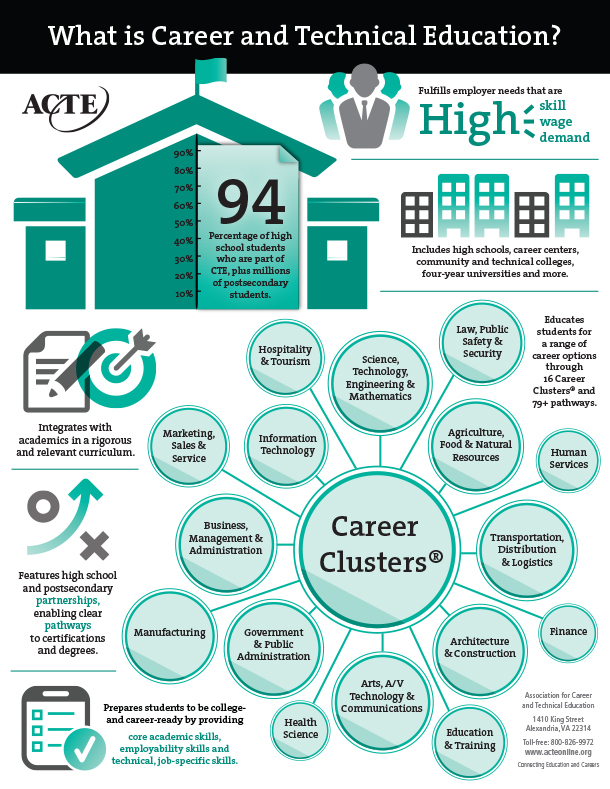State Initiatives Work to Eliminate Lingering Stigma of “Vocational” Education

The push for all high school graduates to earn a four-year baccalaureate degree over other post-secondary pathways has resulted in employers struggling to find workers with in-demand technical skills. Vocational education—now more commonly referred to as career and technical education (CTE)—has an image problem, and students (and parents) are skeptical about the workforce value of a two-year degree or credential.
But efforts are underway to change public perceptions about these programs and eliminate the lingering stigma that middle-skills jobs are second-class options.
California
In California, a statewide career and technical education campaign is working on rebranding CTE as an affordable pathway to a well-paying career.
First introduced in July 2017 by California Community Colleges, the initiative
stress[es] the benefits of CTE programs as cost-efficient, accessible ways to secure stable, income-producing jobs.
To accomplish the goal, the campaign clearly defines these programs as “career education.” And it emphasizes this new brand through a $6 million communications campaign that uses social media, television and local events to show state residents how effective career education can be.
Career and technical education remains a tough sell to students and parents, but that’s because there is also confusion about what CTE means, according to research from California Community Colleges.
…California Community Colleges’ research recently showed a mere 16 percent of surveyed college students are versed in CTE programs; and 46 percent had “either never heard of the term or didn’t know anything about it.” Further, 60 percent were not familiar with the term CTE at all.
Pennsylvania
In Pennsylvania, Governor Tom Wolf recently announced a budget proposal to include a $50 million investment in workforce realignment in K-12 education. This “first-of-its-kind” initiative will invest
in job training and the launch of PAsmart, a realignment of workforce development from K-12 education through career programs so students and workers gain the 21st Century skills to get good jobs that employers demand.
The $50 million for PAsmart will go toward
a $25 million increase in STEM and computer science education at all levels. Nearly 300,000 jobs in the commonwealth require skills in Science, Technology, Engineering, and Mathematics (STEM). Over the next decade, more than 70 percent of new jobs will require these skills.
a $7 million increase in apprenticeships with a goal of doubling the number of registered apprentices by 2025. Since Governor Wolf established the commonwealth’s first Apprenticeship and Training Office in 2016, the number of registered apprentices has increased 14.5 percent, from 13,282 registered apprentices to 15,208.
a $3 million increase for Industry Partnerships which bring together workers and multiple employers in the same industry in a public-private partnership to provide job training.
a $10 million increase to develop Career and Technical Education and STEM career pathways to help students learn about career options and earn an associate degree at a lower cost and in less time.
a $5 million increase to encourage employers to partner with colleges and universities to develop educational programs that prepare students for the jobs high demand jobs that local employers need.
Minnesota
Minnesota is contending with its own skills gap and in-demand positions that need filling, especially as an aging population of workers retire and need to be replaced by new and younger workers. As detailed in the Center’s report “No Four-Year Degree Required: A look at a selection of in-demand careers in Minnesota,” fields that require an associate’s degree or a certificate or diploma are high-paying career paths that span a variety of occupations and job duties, offering opportunities for workers interested in a number of different fields. There are many excellent educational institutions and training programs for Minnesotans, and helpful resources for students, parents, and employers can be accessed on the Center’s “Great Jobs” website.
There is a shortage of skilled workers despite millions of Americans still seeking employment, proving innovative initiatives like those in California and Pennsylvania are crucial to moving the needle on workforce development.
Career clusters under CTE are no longer “dirt-beneath-the-fingernails” jobs. They are valuable, high-skilled positions that are in-demand, pay well, and provide stable employment. It will take time to change the stereotype of alternative career paths that don’t require a four-year degree, but progress is vital to meet the needs of the future workforce.